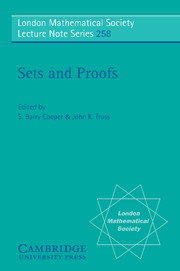Book contents
- Frontmatter
- Contents
- Preface
- An Introduction To Finitary Analyses Of Proof Figures
- What Mathematical Truth Could Not Be – II
- Proof Search in Constructive Logics
- David's Trick
- A Semantical Calculus for Intuitionistic Propositional Logic
- An Iteration Model Violating the Singular Cardinals Hypothesis
- An Introduction to Core Model Theory
- Games of Countable Length
- On the Complexity of the Propositional Calculus
- The Realm of Orinal Analysis
- Covering Properties of Core Models
- Ordinal Systems
- Polish Group Topologies
- Forcing Closed Unbounded Subsets of Nw+1
- First Steps into Metapredicativity in Explicit Mathematics
- What Makes A (Pointwise) Subrecursive Hierarchy Slow Growing?
- Minimality Arguments for Infinite Time Turing Degrees
Ordinal Systems
Published online by Cambridge University Press: 05 September 2013
- Frontmatter
- Contents
- Preface
- An Introduction To Finitary Analyses Of Proof Figures
- What Mathematical Truth Could Not Be – II
- Proof Search in Constructive Logics
- David's Trick
- A Semantical Calculus for Intuitionistic Propositional Logic
- An Iteration Model Violating the Singular Cardinals Hypothesis
- An Introduction to Core Model Theory
- Games of Countable Length
- On the Complexity of the Propositional Calculus
- The Realm of Orinal Analysis
- Covering Properties of Core Models
- Ordinal Systems
- Polish Group Topologies
- Forcing Closed Unbounded Subsets of Nw+1
- First Steps into Metapredicativity in Explicit Mathematics
- What Makes A (Pointwise) Subrecursive Hierarchy Slow Growing?
- Minimality Arguments for Infinite Time Turing Degrees
Summary
Abstract
Ordinal systems are structures for describing ordinal notation systems, which extend the more predicative approaches to ordinal notation systems, like the Cantor normal form, the Veblen function and the Schütte Klammer symbols, up to the Bachmann-Howard ordinal. σ-ordinal systems, which are natural extensions of this approach, reach without the use of cardinals the strength of the transfinitely iterated fixed theories IDσ in an essentially predicative way. We explore the relationship with the traditional approach to ordinal notation systems via cardinals and determine, using “extended Schütte Klammer symbols”, the exact strength of σ-ordinal systems.
Introduction
Motivation
The original problem, which motivated the research in this article, seemed to be a pedagogical one. Several times we have tried to teach ordinal notation systems above the Bachmann-Howard ordinal. The impression we got was that we were able to teach the technical development of these ordinal notation systems, but that some doubts in the audience always persisted. It remained unclear why one could get a well-ordered notation system by denoting small ordinals by big cardinals.
- Type
- Chapter
- Information
- Sets and Proofs , pp. 301 - 338Publisher: Cambridge University PressPrint publication year: 1999
- 5
- Cited by

